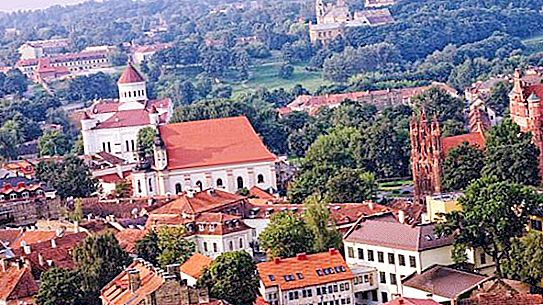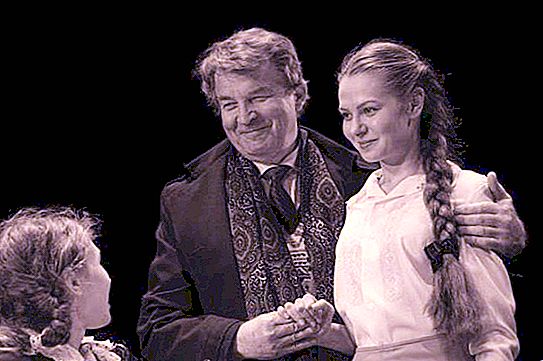The modern emblem of Vilnius is associated with the Christian religion, its main figures are Jesus and St. Christopher. However, it is believed that before it portrayed the characters of pagan myths. What does the emblem of Vilnius symbolize now? What is his story, and what did the previous versions look like?
Capital of Lithuania
Vilnius is the main city of the Republic of Lithuania. By European standards, it is quite large. With a population of 545 thousand people, it ranks second among the cities of the Baltic states. It has been known in history since 1323, although it most likely existed before.
It immediately became the capital of the Principality of Lithuania, and in the 16th century it was considered the center of culture and science. Vilnius survived the epidemic, at least five big fires and was plundered several times and badly destroyed by Russian troops with the Cossacks.
He still retained the status of the most important city in the country. Now Vilnius represents the largest financial, transport, economic and tourist center of the country, which is visited annually by about a million people.
Coat of arms of Vilnius: description
The current city emblem has two versions. One is represented only by a shield, on the other, expanded, around it are shield holders and a motto. The small coat of arms of Vilnius is a Spanish red heraldic shield rounded from the bottom, in the center of which are placed white figures of saints.
St. Christopher is depicted as a strong muscular man with a beard. He is barefoot but wearing a cloak. In his hands he holds a golden staff, at the end of which is a double cross. The saint leans on him, passing along the river, depicted in the form of wavy white lines.
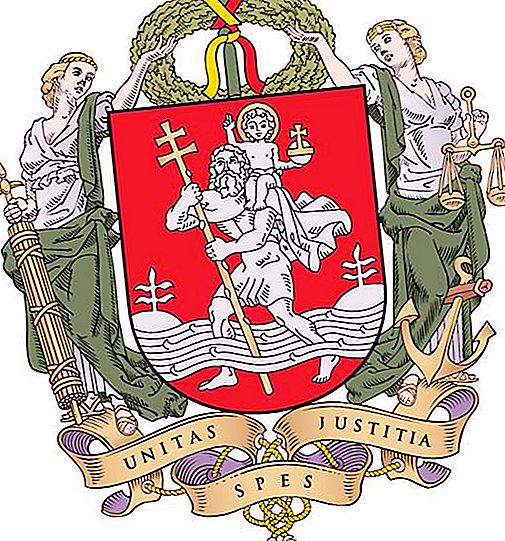
On the left shoulder of St. Christopher sits little Jesus. Above his head is a golden halo, in his left hand he holds a ball with a golden crown and a cross - a power. His right palm is raised, the index, middle and thumb are pointing up, the rest are folded to the palm.
On the large coat of arms of Vilnius, next to the shield, are two girls dressed in gray-green clothes. They are much larger than him, which is not too typical of the heraldic tradition. On the left side of the viewer, the girl holds fascia of the lictors, the girl on the right holds the scales in her hand, and there is an anchor at her feet. With their free hands they hold a wreath above the shield, tied with three ribbons of yellow, red and green.
Girls stand on three ribbons interconnected by a yellow rope. Each of the tapes is written according to the word, together they form the motto: "Unity, justice, hope."
Coat of arms
Each symbol on the emblem of the city of Vilnius is not there by chance. All of them have their own meaning, and some are associated not only with Lithuania, but also with world traditions. So, the common symbol is the fascia. This is a bundle of twigs of birch or elm and an ax tied to them. They mean unity, justice and state power.
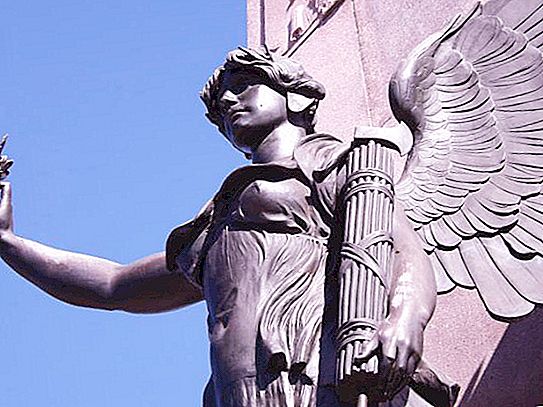
Another symbol of justice from the coat of arms of Vilnius is scales. These attributes are often depicted together. The anchor at the feet of the girl who holds the scales is a symbol of hope. Thus, all three postulates embodied in the motto of the coat of arms are embodied. Three ribbons on a wreath are painted in the colors of the flag of the country.
St. Christopher is often depicted with a baby on his shoulder. According to legend, he was of enormous growth and dreamed of serving Christ. The holy hermit first told him to settle by the river and help people cross it. Once such a request was made to him by a boy who turned out to be Jesus. After this, the giant was baptized, giving him the name Christopher, which means "he who carries Christ."
The saint's staff ends with a double cross designating the cross on which Jesus was crucified. This symbol is also present on the coat of arms of Lithuania. Since 1386, it has been a major element in the heraldry of the royal Jagiellonian dynasty. Christ's right palm is raised in a blessing gesture.
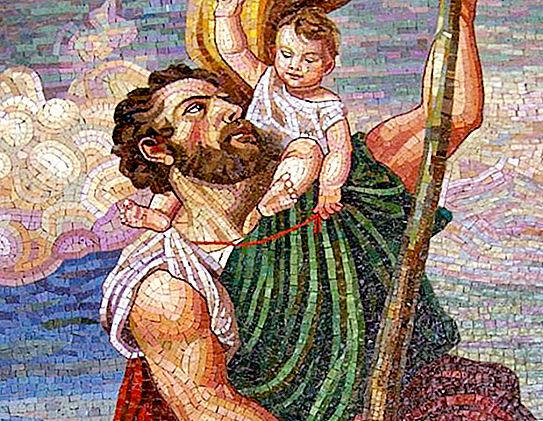
History
It is believed that the coat of arms of Vilnius appeared in the XIV century, in 1330, shortly after the founding of the city. Saint Christopher and Jesus were already depicted in his heraldry. In addition to the coat of arms, they were present at city seals.
From 1795 until the First World War, Lithuania became part of the Russian Empire. During this period, the coat of arms depicted a rider running on a horse. It was approved in 1845 and stayed the main symbol of the city for more than a hundred years, until in 1990 the local authorities established the old, historical emblem of Vilnius.
Giant Alcis
There is a version that Christian saints were not always symbols of the city. Some historians claim that the earlier seals depict the legendary Alcis with his wife Yaterinte, and not St. Christopher and the baby Jesus at all.
The giant Alcis or Alkida are famous heroes of Lithuanian folklore who have accomplished many deeds. According to one of the tales, he defeated the dragon and saved from him the beautiful princess, who became his wife. It was her who he carried through the stormy Vilnius river.
After the adoption of Christianity, pagan heroes became irrelevant and some characters replaced others. However, the version is not official, many believe that it was invented by the historian Narbut in the 19th century.
